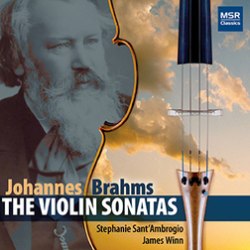| 
|
Johannes BRAHMS (1833-1897)
The Violin Sonatas
Scherzo in C Minor, Wo02 [5:33]
Sonata No.1 in G major, Op.78 [28:59]
Sonata No.2 in A major, Op.100 [20:21]
Sonata No.3 in D minor, Op.108 [21:43]
Stephanie Sant’Ambrogio (violin)
James Winn (piano)
rec. February 2013, Wells Fargo Auditorium, University of Nevada (Reno), USA
MSR CLASSICS MS1483 [76:36]
This disc of Brahms’ violin sonatas presents just a very small part of the composer’s complete output. There were high expectations even before I’d pressed play. What followed lived up to those expectations … and more.
The Scherzo in C Minor, which is rhythmically very exciting, provides a bold opening. Part of a sonata composed for a friend of Brahms by Robert Schumann, Schumann's student Albert Dietrich and Brahms himself, the Scherzo is the most famous and most performed part of this relatively obscure work. At first I was unsure why it was selected to be on this disc of full sonatas without its counterparts. As soon as I started listening the reason became apparent. It works as a great opener. It’s exciting and gives listeners a taste of typical Brahms chamber music, preparing us for the sound-world in which they are about to immerse themselves. The sheer amount of character in the violin alone (a 1757 model by J.B. Guadagnini) is instantly apparent, and what a beautiful instrument it is. Combined with the immensely skilful playing of Ms. Sant'Ambrogio, it is a delight to hear.
The ‘Sonata in G Major’ is very lyrical, and the call and response sections between piano and violin are nicely balanced. Throughout the disc the instruments and players never overwhelmed each other. Each has his or her role and a distinctive character yet these are voiced without damaging the blend. There is no fight for dominance between the instruments, which is very nice to hear. Sant’Ambrogio and Winn are clearly experienced in performing together, and their combined musicianship is astounding. The instruments are always clearly discernible from each other, but never so separate as to be disconnected. Another highlight was Movement III of the ‘Sonata in D Minor’ - with a variety of musical moods ranging from the playful to the solemn to the grand. It made for very enjoyable listening.
There is a directness of expression in Brahms' melodic writing that is remarkably intense, and it is recreated here remarkably well. As an experienced classical musician listening to these sonatas for the first time - I'm more of an early musician/vocal musician, but have experience of much of Brahms’ vocal works - I believe that it is some of the most beautiful melodic writing I have ever had the privilege to experience.
Even before this disc I enjoyed Brahms’ music, but this took me to a whole new level of admiration, not least because of the remarkable musicianship of these two performers.
Unfortunately, at the very end of the ‘Sonata in G Major’ there is a period of ten seconds or so after the piece has finished that is still being recorded, and the natural post-take movement and string checking is all picked up. The engineers should have known better in terms of the take. The recording should have been stopped at the right time. This is not after all a ‘live’ disc and has been through the editing process. That this was not noticed and removed was sloppy and very nearly took away from the wonderful atmosphere generated in the sonata.
However, one minor blemish should not take away from the disc as a whole - it really is a wonderful disc, and whether you are being introduced to Brahms for the first time or are a seasoned Brahms lover, this recording is a strong contender.
Jake Barlow
www.jake-barlow.com
 |
 |
|
